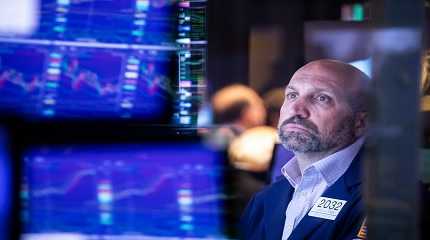
NEW YORK, Dec. 31 (Xinhua) -- Wall Street had a brutal 2022, as surging U.S. inflation has prompted the most aggressive Federal Reserve rate hike campaign in decades, raising fears about a potential recession.
All three major indexes suffered their worst year since 2008. The Dow dropped 8.8 percent in 2022, while the S&P 500 tanked 19.4 percent and the technology-heavy Nasdaq slumped 33.1 percent.
Despite the steep sell-off, many analysts believe that the market's pain may not be over yet, warning of downside risks, especially in the near term, as lagging effects of tighter monetary policy work their way through the economy.
TIGHTENED FINANCIAL CONDITIONS
The S&P 500 Index is expected to fall about 9 percent in the next three months before rebounding after the Fed's tightening cycle ends in May, strategists at Goldman Sachs Research said in the team's year-ahead outlook.
They forecast the benchmark to turn out flat returns and no growth in earnings in 2023.
The Fed has raised interest rates by a total of 425 basis points since March 2022 in an aggressive bid to rein in inflation, and signaled more rate hikes on the way through next year.
The rapid increase in interest rates has sharply driven up the cost of capital for U.S. firms, which has translated into a drop in valuations, especially in growth stocks.
Goldman Sachs strategists expect the weighted average cost of capital for U.S. companies to remain high in 2023.
"The Fed will likely seek to keep financial conditions sufficiently tight to maintain below-trend economic growth and contain inflation," they said, noting "this policy means limited valuation expansion and limited upside to equities, a key component of financial conditions."
"While not our economists' base case, a U.S. recession is forecast to spark around a 20-percent decline in the S&P 500," they added.
WORSENING U.S. MARKET IN H1 2023
The average forecast expects the S&P 500 to end 2023 at 4,009, according to Bloomberg, representing an increase of 4.4 percent from Friday's close of 3,839.5. While varying in their predictions of the target price, most analysts warned that the market could get worse before getting better amid a challenging macro picture.
Economists and strategists at Bank of America Global Research said the upcoming year should be a story of two halves with corporate earnings and economic growth under pressure in the next several months.
They expect to see the S&P 500 dipping to as low as 3,000 in the first half on recession risks, earnings cuts, and elevated rates, adding "the backdrop for stocks should be better in the later half."
The bank sets a 2023 year-end target of 4,000 on the benchmark index as annual earnings per share for the S&P 500 are seen declining 9 percent next year to 200 U.S. dollars.
"This sell-off combined with disinflation, rising unemployment and declining corporate sentiment should be enough for the Fed to start signaling a pivot, pushing the S&P 500 to 4,200 by year-end 2023," said Dubravko Lakos-Bujas, chief equity strategist at J.P. Morgan.
SLOWING U.S. ECONOMY FOR 2023
There have been increasing signs that point to a slowing U.S. economy, but the Fed has remained hawkish thus far.
The central bank's updated economic projections released in mid-December showed that policymakers saw benchmark rates rising to a median level of 5.1 percent in 2023, above the 4.6 percent forecast back in September, suggesting a target range of 5 to 5.25 percent, or roughly another 75 basis point rate hikes ahead.
Meanwhile, Fed officials outlined more pessimistic forecasts for unemployment, which they now see rising to 4.6 percent next year. They also scaled back expected economic growth from 1.2 percent for 2023 to just 0.5 percent.
UBS analysts said that U.S. stocks are still not out of the woods, citing uncertainty over inflation, the Fed's future rate path, and the economic and corporate profit landscape.
Heading into 2023, equity markets could slip in the near term, but the outlook should improve later in the year and into 2024, they said.
Larry Benedict, CEO and founder of The Opportunistic Trader, a U.S. market research firm, told Xinhua that he expects continued market volatility ahead, noting the first quarter of 2023 will be "rough."
"The market will be in recession by end of the first quarter, followed by a rally. 2023 prediction is lower on the year but not as bad as 2022," said Benedict, who has over thirty years of experience as an investment professional.
LPL Financial's Chief Global Strategist Quincy Krosby told Xinhua that "the key drivers for the equity market will be the level of interest rates, the condition of the labor market, and consumer confidence."
"If higher interest rates weaken the economy significantly during the first half of 2023, the drivers of the market will be the economic recovery underpinned by lower interest rates," she said.




